Microsoft Surface 2 Review
by Anand Lal Shimpi on October 21, 2013 12:00 AM ESTThe New Display
Microsoft spent a lot of time defending its decision to use a 1366 x 768 panel in the original Surface RT, all the while knowing its successor would move to the same 1080p panel as its bigger brother. With Surface 2 Microsoft thankfully embraces the importance of relatively high resolution displays in tablets. The 10.6-inch 1920 x 1080 display weighs in at just over 207 pixels per inch, which isn’t too far off rMBP standards although still shy of the iPad with Retina Display. A higher resolution panel isn’t absolutely necessary here, and given the 64-bit memory interface of Tegra 4 (and its associated GPU power) I don’t know that we’d want something substantially higher in Surface 2.
By default Surface 2 ships with 150% DPI scaling enabled, and for the most part it works well in the limited selection of classic desktop apps that ship on the machine. Since you can’t install third party classic desktop apps there’s no real chance for anything to go wrong on the DPI scaling front.
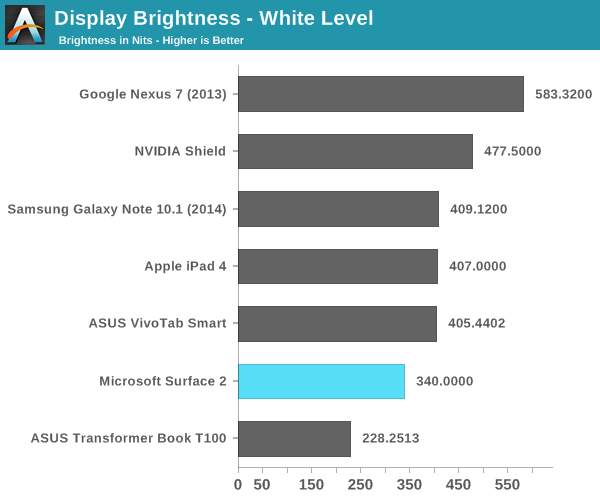
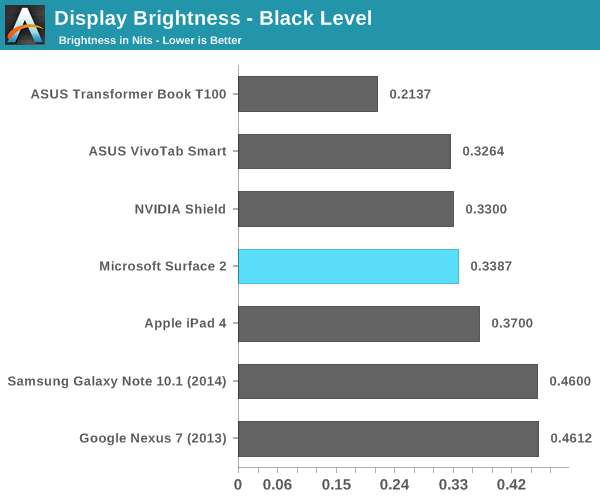
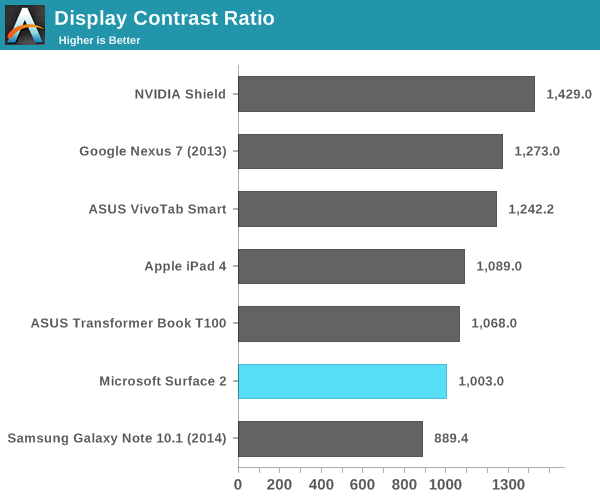
Color accuracy is much improved compared to Surface/Surface Pro. Microsoft openly admitted to not targeting full sRGB coverage at the Surface 2 launch event, which means that you’re not going to see Surface 2’s color accuracy equal that of the Nexus 7 or iPad with Retina Display. Subjectively the display looks very good, a huge improvement over last year’s model.
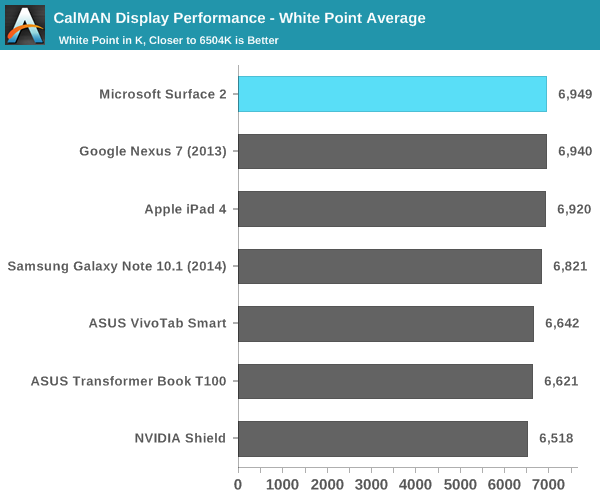
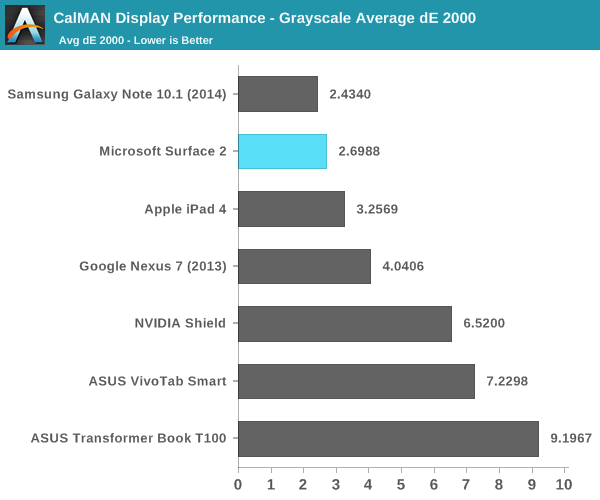
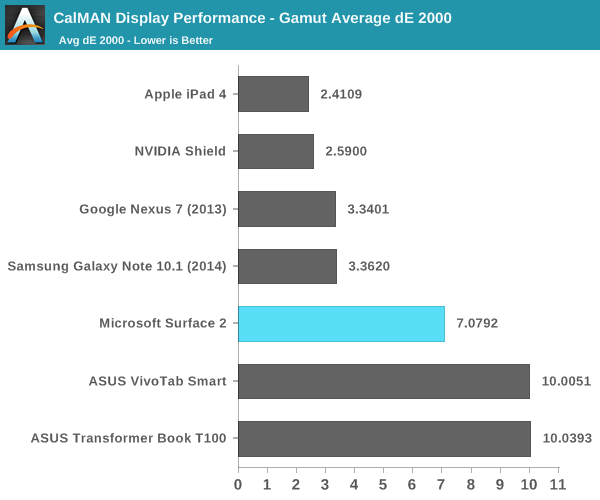
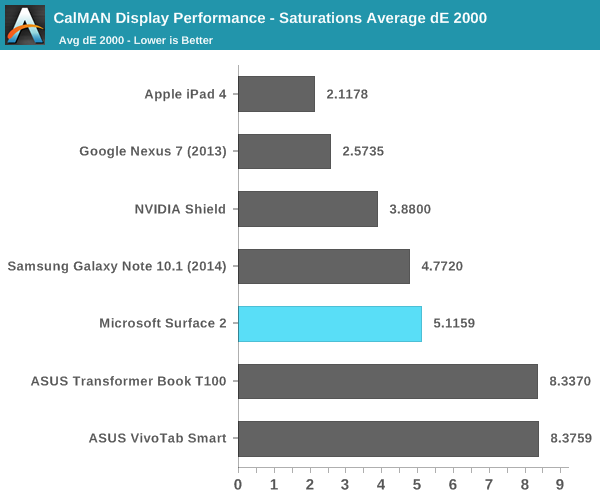
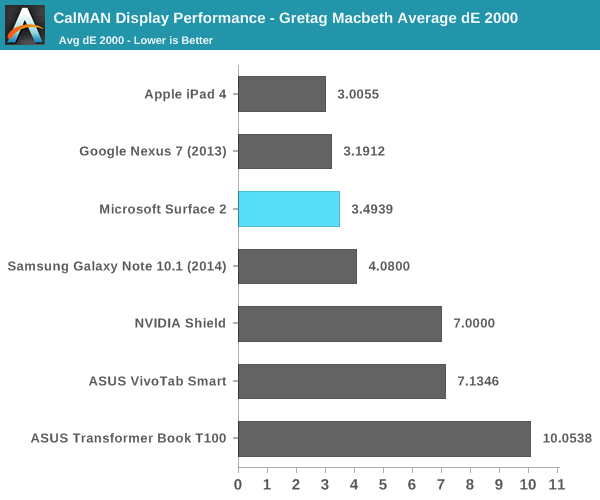
Grayscale accuracy is actually quite good, as is Surface 2’s performance in our GMB pattern test. Measuring accuracy while we scale color saturation however has the Surface 2’s display falling short of the competition, and our basic gamut test doesn’t come out very strongly either.
Microsoft continues to be proud of the fact that its Surface 2 (and Pro 2) displays are laminated to their cover glass to help reduce reflections. In practice I can say that this helps improve the overall experience while using the devices.
Overall display performance isn’t bad at all, and it’s an improvement over what Microsoft shipped last year, but it could definitely be better. Google set the new bar with the $229 2013 Nexus 7’s display and all competitors really have to meet it at this point.


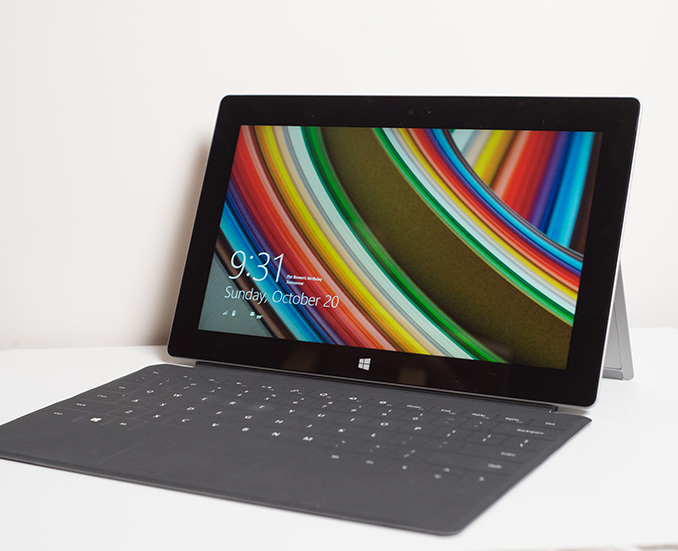








139 Comments
View All Comments
Da W - Monday, October 21, 2013 - link
1- I use both MS and Google services on my surface (pro) and android phone (and dropbox). I do prefer MS bundle overall. I find also that its a generation thing, most aged 30-40Y tend to prefer MS while the younger generation tend to hate MS (and choose Google).2- Every google services, facebook, twiter, most "apps" are accessible in their internet version via ie11 and pinable on the start screen. In fact i think the lack of apps on the Windows store is a non-issue. On my android phone, i use mostly apps and almost never use the chrome browser. On my surface it's the opposite, i use almost no apps and do everything i need in the browser. (working in the browser is also the point of google chrome, so it's not a bas thing).
I think the # of app issue is overrated.
3- Agreed you can put Windows RT in the same class as google chrome, functionnality wise. That is: a limited OS that can't do what other mature OSes can.
Wolfpup - Thursday, October 31, 2013 - link
It is kind of Microsoft's version of a Chromebook, BUT it still does more. It still has local programs (even if you can only get them through the store). It still has much more of a real file system and has printer (and I think even scanner now?) support, etc.RannXeroxx - Friday, November 29, 2013 - link
Actually I think you have it wrong. Its people in their late 20s or mid 30s that seem to hate MS but younger people, just like they don't connect to the cold war or the fear of the USSR, they don't connect with the Microsoft Monopoly of the 90's and think of MS as XBox and WP8.prophet001 - Monday, October 21, 2013 - link
Good post sri_tech.hoboville - Monday, October 21, 2013 - link
Sorry, but that's an apples and oranges comparison. Chrome vs. Windows isn't the issue. It's Windows RT vs. Windows x86. With RT you get a gimped version of Windows that relies on the M$ Store for apps if you go with RT. If you go with Pro, you pay out the face for a device that is simply a super light, small touch-screened laptop. The great thing about Windows was that it could run a bajillion different x86 programs...not with RT though.Ok, so I'll pay $800 for a Pro? For $700, you can get a Haswell laptop with full x86 features (not gimped ARM derpness) on the Windows platform. You'll get the same battery life, a bigger screen, more storage space, the ability to upgrade, and more RAM. Don't forget the fact it has a real keyboard.
As Anand said: "When we first posted about ASUS’ T100, common feedback was that users would be willing to pay more for an even better device. A Bay Trail Surface 2 could’ve been that device." That's exactly my point, the RT could have waited 3-4 months ditched Tegra and gone to Bay Trail, which is extremely efficient, more powerful, and is x86. For $500 a full x86 tablet with Windows 8 would be a bombshell. It would have most of the features of a laptop while being a tablet. However, M$ is more concerned about roping people in to the M$ Store where they can cash out on apps BECAUSE the RT is a closed platform. They want you to get RT because it means they can milk you for most cash. If you want x86 they will charge you out the wazoo because they know once there, you can use any program you want.
trip1ex - Monday, October 21, 2013 - link
I don't think people want Windows x86 tablets. I think people want to ditch Windows. :)kyuu - Monday, October 21, 2013 - link
You're confusing "people" with "you".Why should I (or people) want to ditch Windows? What does iOS or Android offer that Windows doesn't? As far as I can tell it's nothing but a regression in features either way. OSX? I've used it and had the option for years. Still not interested. Linux? I can see the appeal, but again, I've used it and had the option for years. Nothing has changed that makes it more appealing than Windows for me or your average user.
ChromeOS? Don't make me laugh.
You want to avoid the malware situation that ignorant users get into on their Windows machines? Windows RT works for that. People who need more out of their OS than WinRT gives them should know enough to avoid malware in the first place.
Hrel - Friday, October 25, 2013 - link
He didn't say google apps were better, he said it depends on which apps you prefer.theduckofdeath - Wednesday, October 30, 2013 - link
Chrome OS does support touch screens. The Pixel has a touch ditto.And just because Microsoft has services, it is not unanimous with them being of equal quality. Personally, I find Google Docs to be more accessible despite the obvious lack of many features. There's no point in having an advanced online Office service, if it's not as simple to use.
thebeastie - Monday, October 21, 2013 - link
Looks pretty decent, I would feel good about recommending this to my clueless relatives who click and install every single web ad that pops up saying its going to "Improve system performance by %300" and installs garbage and maybe even something that attempts to rob them blind.With RT OS I feel assured that won't happen and they can sit and doodle in Office all day and be safe.